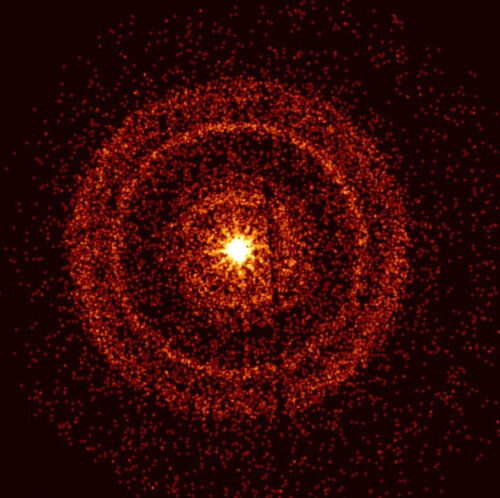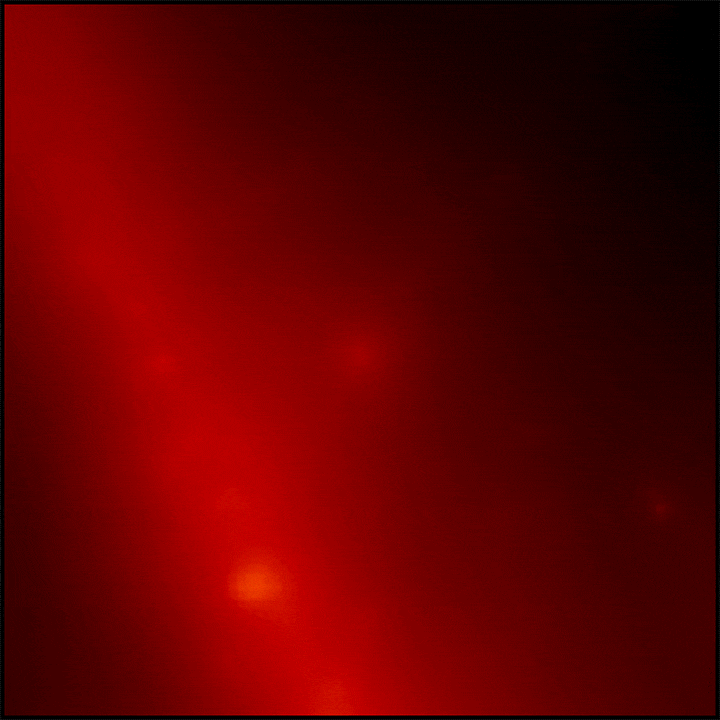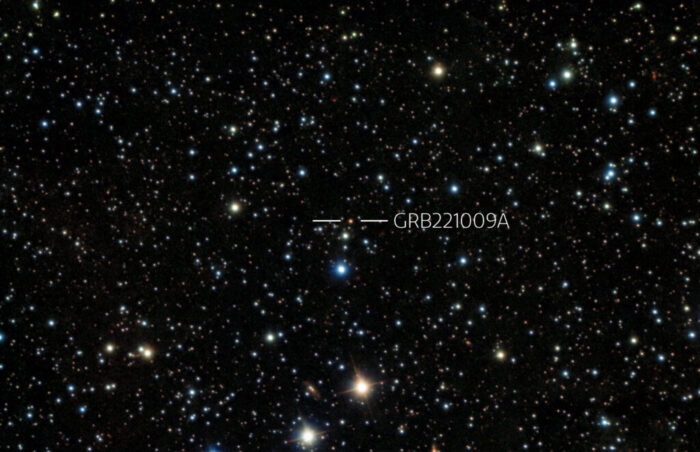Astronomers have just made a brilliant discovery. And we do mean brilliant!
An enormous gamma-ray burst about 2.4 billion light years from Earth is breaking all the records as the brightest cosmic explosion since the Big Bang. (The Big Bang was the seismic energy eruption that is believed to have kickstarted the universe as we know it.)
Though officially known as GRB 221009A, some astronomers have started referring to it as the B.O.A.T. As in 'Brightest Of All Time'. Cute!
So what goes into creating such a huge release of energy? And how do astronomers know it is so massive?
Let's go space sailing for some answers!
BOOM!

A close-up of the gamma-ray burst. (NASA/Swift/A. Beardmore (University of Leicester)
The explosion was almost certainly a large star 'going supernova'. This is when the star runs out of the nuclear fuel to keep the process of fusion going.
Fusion, or joining atoms together into new elements, releases tremendous energy and is how stars do their thing. It is also the nuclear reaction that allows a star to keep its shape and resist the incredible forces of gravity that are trying to pull all of the star's matter inward.
Once this fuel runs out, fusion stops and gravity wins. The star collapses instantly and causes a supernova. The release of energy is incredible! The process then leaves behind a super dense core of matter that is either a neutron star or a black hole.
These two things are the densest known points of matter in the universe. It is like taking all of the matter in our Sun and shrinking it down to the size of a city ... or even a house!
Gamma-ray burst
But we can save the talk of black holes for another post. This post is about the explosion itself. And in particular, the gamma-ray burst, or GRB.
Gamma rays are the highest frequency forms of electromagnetic radiation (this spectrum includes radio waves, microwaves, infrared, and what we know as visible light). They are higher than ultraviolet (UV) rays, higher even than X-rays. All of these three forms of energy are invisible to our eyes, but gamma rays are truly out of our range.
They cannot be reflected by a mirror, and can pass through nearly everything, save for materials like thick concrete or lead. To produce gamma rays, the release of energy is often something truly spectacular. This is why astronomers have set up gamma ray observatories like the Fermi Gamma-ray Space Telescope and the Neil Gehrels Swift Observatory to spot them.
Where you have gamma rays, you have action!
What floats the B.O.A.T.?

This GIF from NASA shows the moment that it went KA-BOOM! (NASA/DOE/Fermi LAT Collaboration)
All supernovas are incredible events and huge sources of gamma rays. So what makes GRB 221009A the B.O.A.T.?
Most GRBs are fast and furious. Even extremely sensitive instruments tend to only pick them up once. But the Swift Observatory was alerted to GRB 221009A multiple times. And the readings show why.
This GRB is around 10 times more brilliant than other recorded GRBs. It is estimated to have released energies of 18 teraelectronvolts (TeV) or higher. That is 18 trillion electron volts, which is a mindbogglingly high amount of power.
It was so bright, long-lasting, and powerful, that astronomers first suspected that it was from somewhere within our own galaxy. That was the only logical explanation as to why it was so potent—it was from relatively nearby.
But once tests revealed that its source was from far outside our own galaxy, astronomers knew that they were seeing something miraculous. And it's something that they want to keep their eyes on.
This boat is a space lab!
The aftermath of this supernova will be visible for months. This will give astronomers a chance to further test out some theories on how certain elements are formed.
In an interview with Live Science, astrophysicist Wen-fai Fong said, "It's theorized that the most energetic GRBs could be birth sites of some of the universe's heavy elements, so this GRB serves as an unprecedented laboratory to test that theory."
What does this mean?
The fusion in stars turns hydrogen into helium. These are the two 'lightest' elements in the universe (they have very few neutron, protons, and electrons in them). But when supernovas happen, it is thought that a variety of heavier elements are created, including metals like iron, lead, and even gold!
Observing the light given off by GRB 221009A could solve this riddle once and for all. Meaning this B.O.A.T. could also end up being the G.O.A.T.!
 It may not look like much here, but this explosion is 2.4 billion light years away! (International Gemini Observatory/NOIRLab/NSF/AURA/B. O’Connor (UMD/GWU) & J. Rastinejad & W Fong (Northwestern Univ)
It may not look like much here, but this explosion is 2.4 billion light years away! (International Gemini Observatory/NOIRLab/NSF/AURA/B. O’Connor (UMD/GWU) & J. Rastinejad & W Fong (Northwestern Univ)









